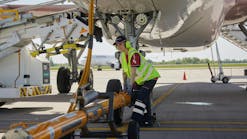This article is part of Ground Support Worldwide’s “Handling with Compassion” series, which looks at the respectful transporting of human remains, including military human remains.
An international trade association for airlines and a worldwide federation of funeral operatives are working to standardize and improve the processes of transporting human remains by airplane.
The International Air Transport Association (IATA) has members from 336 airlines representing more than 80 percent of the global air traffic. IATA provides professional support to industry stakeholders and through its online knowledge hub, offers an on-demand webinar providing guidance on the transport of human remains by air.
Webinar presenters include leaders from IATA and FIAT-IFTA, an organization of funeral operatives from more than 70 countries. The original name of FIAT-IFTA is French, Fédération Internationale des Associations de Thanatologues (FIAT), and English, the International Federation of Thanatologists Associations (IFTA).
IATA and FIAT-IFTA share a common interest in the repatriation of mortal remains and therefore the same objective: providing dignified and safe transportation for the deceased.
Repatriation, returning someone or something to their country of origin or citizenship, when human remains are involved is extremely important, says FIAT-IFTA president Marek Cichewicz.
For family members waiting for the body or ashes of their loved one to return home, Cichewicz says, “at the moment, this body, this deceased, is more important than gold or diamonds, which you deliver … This is something special.
“We are looking for some solutions to improve the reparations of the deceased,” he says.
IATA’s Compassionate Transportation Manual (CTM)
One of those tools is IATA’s Compassionate Transportation Manual (CTM). Now in its fourth edition, the CTM contains guidance needed for funeral home operators, airlines and freight forwarders on how to prepare, ship and handle this special cargo.
Lucy Exell, IATA’s manager of Cargo Industry Programs, says the CTM was born from the COVID-19 pandemic, which took the lives of millions and dramatically increased the demand for repatriation of human remains.
“The situation was further exacerbated by there being no universal international standards for the processing and documentation of the repatriation of human remains by air. There was no single source document available to stakeholders that could provide the harmonized guidance to states and all the other parties from the funeral home, air carrier and across the board,” says Exell.
IATA collaborated with the World Health Organization (WHO) and the International Civil Aviation Organization (ICAO) to create guidance documentation on the transport of COVID-19 human remains shipments by air.
To create the CTM, IATA obtained input from FIAT-IFTA and the Funeral Service Association of Canada (FSAC). Because the transportation of human remains generally requires the services of two funeral homes (one at departure and one at arrival), Exell says, “it was critically important for us to acknowledge their importance.”
Other contributors include IATA airline members, was well as MacKinnon and Bowes Ltd., a provider of support services, including repatriation, for funeral professionals; Hygeco, a funeral service, products and equipment provider; IATA’s TACT Air Cargo Solutions; and Albin International Repatriation.
The CTM follows the IATA Cargo Handling Manual, now in its eighth edition, which has the most up-to-date cargo handling guidelines as well as the 19 steps of the air cargo handling Master Operating Plan (MOP).
“We strive to establish the best standards and make them available to the industry very often in forms of publications,” says Andre Majeres, head of e-commerce and cargo operations at IATA.
“The establishment of standards is extremely important. You can imagine that when you have thousands of airports around the world with thousands of parties, which are handling the cargo, we have to establish a standard available for all to make sure that we will all work the same way,” Majeres says.
The MOP, he explains, is a journey of a piece of cargo from the shipper to the consignee from the moment it’s picked up at origin until delivery at destination.
Processes, subprocesses and sub-subprocesses are as detailed as possible, says Majeres, “so that you have the exact working instruction, procedure on how to deal with your freight be it general cargo, be it dangerous goods, live animals or human remains.
“It is of the utmost importance that you have the right processes in place. If you don’t have the right processes in place, you will only face surprises and no one likes surprises,” he emphasizes.
Additions to the CTM
Since the CTM was first published, more subjects have been included. They include introducing sustainable business practices, embracing electronic data exchange programs, risk assessment, and competency-based training.
Compassionate Transportation training
Recently, (June 25), IATA launched the Compassionate Transportation LIVE virtual classroom course. Registration is now open registration for the August and October courses. The course is intended for funeral operators, air cargo agents, airlines, freight forwarders, entry-level regulators and other industry stakeholders.






